7 Ceiling Fan Alternatives: Keep Cool Either Way!
Author: Rick Worst | Editor: Omar Alonso
Review & Research: Jen Worst & Chris Miller

There's a ton of reasons to seek out ceiling fan alternatives, but those matter far less than finding an option that gets the job done when you don't have or can't have the overhead type.
We won’t lie; ceiling fans rank high on our list of favorite 19th-century inventions. These “cool” gadgets keep temperatures low, can be multifunctional (chandeliers-ceiling fan combos, anyone?), and can be used either indoors or outdoors.
Further sweetening the deal is the fact that your electricity usage, and hence, your electricity bill, will be as low as it's ever been without any compromise on the fan’s functionality.
However, ceiling fans can be noisy and distracting, not to mention quite passe. Though their functionality has found many fans, not many people love the aesthetics they lend to the room... lights and cooling quotient included.
And unless you’re really meticulous about cleaning and especially dusting, the chances are that it’s been a good decade since you last cleaned that ceiling fan.
Don’t worry, we totally get you — dragging the ladder from the garage to the living room, climbing up, staying up, and trying to get your fan clean while battling all the sneezing isn’t exactly how you’d want to spend that one, much-awaited day off.
Fans tend to collect dust quite easily and you’re going to be treated to a shower of cool air and a generous bonus of dust if your fan hasn’t seen a good cleaning in a while.
7 Ceiling Fan Alternatives
Point being, if you want to say goodbye to your ceiling fan in favor of a more chic option that can be used with any types of ceilings, or you have a low ceiling, or simply want to do up your new room sans the ceiling fan but plus the cooling, here’s a list of ceiling fan alternatives to consider.
Tower Fans
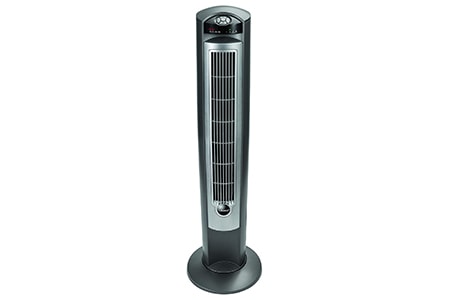
Tower fans are an amazing option to consider; their thin size doesn’t take anything away from the generous, powerful wind streams that they can produce.
These vertically-oriented towers are also capable of swaying on their base, ensuring that everyone reaps the benefits of their cooling capacity as air circulates through the entire room.
Additionally, these fans come with many options that let you decide how intense you want the stream to be, how much the fan should sway, speed settings, and so on.
Though many tower fans come with air ionization capabilities that give you cool and fresh outdoor quality air in your living room, some let you pour in cool water for even-cooler air; heaven sent on a hot summer afternoon.
The shape of the tower fan also provides a benefit apart from the vertical air stream; you can fit it into places where a ceiling fan wouldn’t fit, such as that nook right next to your favorite reading spot sofa. Most tower fans are also portable and remote controlled.
Since the blades are enclosed in a plastic body, there’s very little risk to safety—a huge plus if you have little kids or pets in the house.
However, the bigger the area, the bigger your tower fan will need to be (or you’ll need to buy more than one fan), as these gadgets aren't industrial strength.
Some tower fans can also be noisy, so if a quiet alternative to your ceiling fan is what you wanted, a noisy tower fan is, quite obviously, counterproductive!
Window Air Conditioner
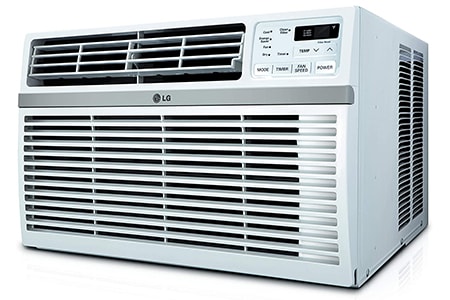
By far the most common and most popular alternative to ceiling fans, these types of air conditioners grace a majority of homes across the United States.
These units provide dry air that keeps away the heat and are great for both residential and commercial settings.
Many homeowners, especially in older cities, opt for window AC units, a highly economical option both in terms of purchase price and electricity usage.
You can opt for a central air conditioning unit (one unit to cool the entire floor of the house) or a separate unit for each room; the latter is a less expensive option as you can control them independently only when needed.
Another great thing about air conditioning units, apart from the rapid cooling, is that even after turning them off, the coolness stays for a considerable bit of time thanks to your home's insulation.
If you are investing in a window unit, ensure you install it properly, to prevent any residue or dust from making their way into your house. These alternatives to central air are fantastic but they do require you to pay attention to them occasionally.
Do bear in mind that if you plan to buy quite a few units (which you will need to do if you want to cool more than one room at a time), the collective expense could work out to be quite high, but it’s worth the dust-free cooling.
If you’re investing in central air conditioning, you’ll definitely end up paying quite a bit and requiring professional help to set it up, but on the plus side, you’re assured of even temperature and excellent air quality throughout your home.
Pedestal Fans
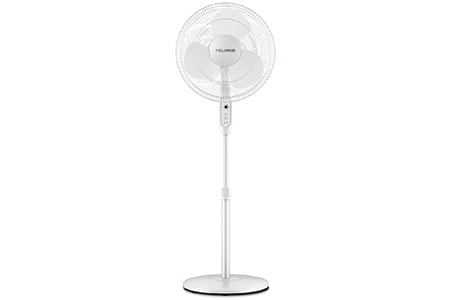
Pedestal fans may seem as outdated as ceiling fans but the right pedestal fan can really bring an industrial-chic-decor vibe to your room. They’re excellent for small spaces and can double up as a dryer when you need to quickly dry some wet clothes.
Like tower fans, pedestal fans also sway and come with a range of settings that let you control the speed, intensity and direction of airflow. They’re also much quieter than ceiling and tower fans and may or may not be remote controlled; they’re also quite powerful.
Unlike tower fans, you can also tilt the head of the pedestal fan to angle the airflow as you wish for direct cooling, letting it sway for more gentle cooling, or point upwards for air circulation.
Additionally, most pedestal fans come with adjustable height features, which makes them an excellent option for houses with low ceilings. They can also be moved from spot to spot; some fans even feature wheels to enhance their portability.
However, if you’re looking to enhance the aesthetic value of your room, a pedestal fan may not do the job for you. In my opinion, every home should have one of these types of fans to cut down on the power bill whee you don't need to cool the whole home.
It’s more likely that you’ll have to change the whole look of the room to match your new fan or settle with having a bit of an eyesore. Nailing the overall look and aesthetic is extremely crucial when opting for a pedestal fan.
They can also present a bit of a safety hazard as the blades are large and exposed for the most part, which isn’t great when you have kids running around the house, and if it’s a lightweight fan, the chances of it being knocked over and becoming a casualty in a game of tag are quite high, too.
Box Fans
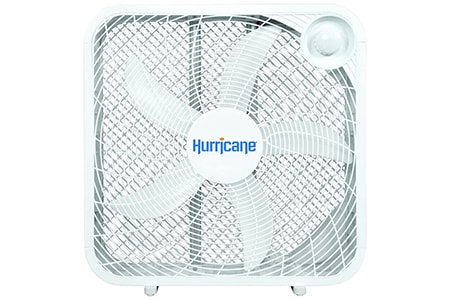
We’re big fans of these fans, one of the most recognizable fans in the market. As the name suggests, these fans come in box-shaped frames and are generally huge, with a grill or cross section to enhance airflow.
Place them on a window and you’ll find the fan drawing the cool air from outside and into your space. Growing up, these box fans were critical for me since my room was so hot compared to others.
Box fans are big enough and powerful enough to cool entire rooms by themselves. However, they’re light enough to easily transport from room to room without taking away from their power and functionality.
When picking out a box fan, ensure that you bear in mind what size you’ll need and what controls you’d like on it; these fans also come with a range of settings for speed and intensity.
However, unlike tower and pedestal fans, they can’t sway, so you can only enjoy a direct stream of air. They make great white noise generators for a bedroom, as my grandmother always recommended.
Attic Fans
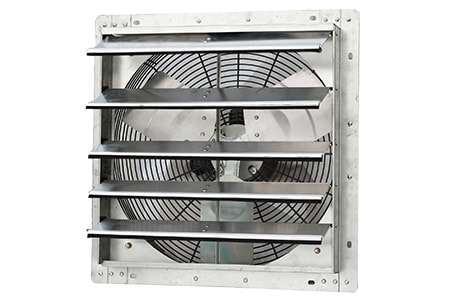
Attic fans can be mounted on your roof or gables, making them an easy and convenient option for most homeowners.
These fans work by expelling the hot air from the inside of your house to the outside, like an exhaust fan, and are one of the cheapest yet most effective options out there.
In addition to blowing the hot air out, attic fans also keep out the moisture and reduce the risk of mold or mildew growth inside the house, taking away the need to worry about damp spots in your house.
Additionally, they’re great for dust and dirt control, as they keep air constantly flowing in and out of the house, which also assures you of fresh, quality air.
As a bonus, attic fans may also increase the value of your home, since pretty much everyone prefers cool homes with good airflow, leading to you getting you a good deal if you ever plan to sell your house.
However, bear in mind that too much insulation in the attic can make it difficult for your attic fan to function, as this blocks the airflow.
Additionally, there’s no mechanism to filter the air that comes from outside, which means germs and bacteria could find their way into your space, but no worse than opening a window occasionally.
Bladeless Fan
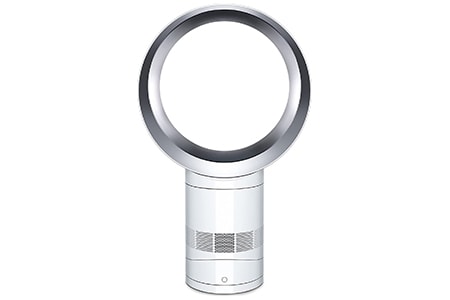
The kings of the bladeless fan, often called an air multiplier, are Dyson. These look like a fan without any blades extending from the center.
The way it works is that they suck air in through the base and then blow it through a thin tube that travels through the surface of the circle or oval shapes (the part that resembles the fan). The high velocity but thin bursts of air move a lot of air across surface areas, cooling them quickly.
These may look futuristic but they were actually invented by Toshiba in 1981. The rings that blow out the air passes the air across a shape fashioned like an aircraft wing, taking advantage of something called the Coanda effect.
This makes sure the air flows smoothly with a laminar flow instead of turbulently like you get with fan blades chopping through the air. These are super cool and fashionable but pricey. They overcome problems with ceiling fans like imbalanced blades, the ceiling fan making clicking sounds, and other issues.
Desktop Fan
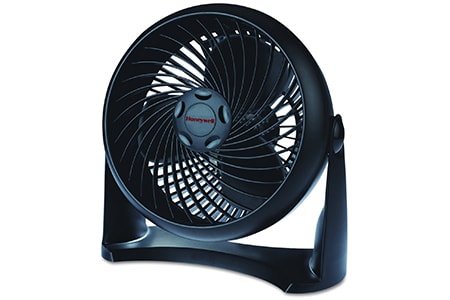
I once worked at a place that caused me to live and sleep in a cabin without electricity for four nights a week. All of us workers had our own personal battery powered desktop fans.
Sometimes called table fans, these small and portable fans aren't much different than a smaller box fan. We used to place them right on our chests to blow our faces during the hot summer nights.
There are also electrical versions you plug into the wall and even some you can plug into a USB port on your laptop, for instance. These can even be nice on the kitchen counter if you need air flow and don't want to have a ceiling fan in the kitchen.
Ceiling Fan Alternatives Can Keep You Cool
If you’re not a fan of ceiling fans, for whatever reason, you’ll now be heartened to know that these many options exist as alternatives to a ceiling fan. Maybe you have a drop ceiling and don't want to deal with the drop ceiling alternatives, which require much more work.
Some of these options are more functional than aesthetic, while some are exactly the opposite, and with some, it’s a tricky balance between both, but the effectiveness of these alternatives cannot be disputed.
If none of these options catch your fancy, you can also consider wall-mounted fans, or ultimately, just go ‘au natural’ and leave the windows open for some old-fashioned cooling. Either way, those are just more ceiling fan alternatives for you to consider.



